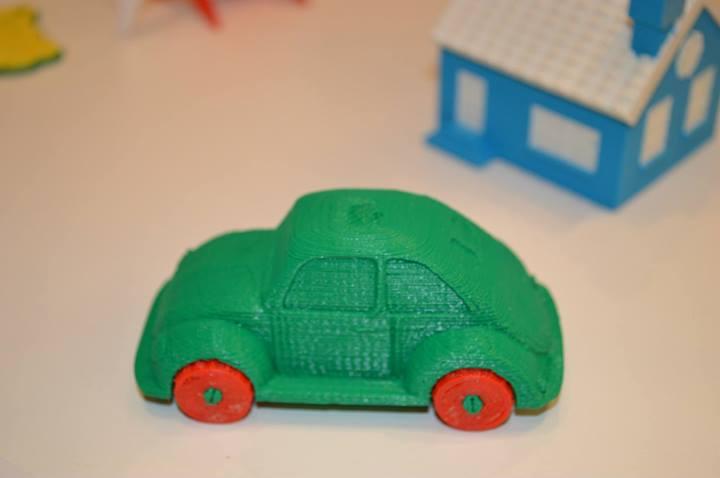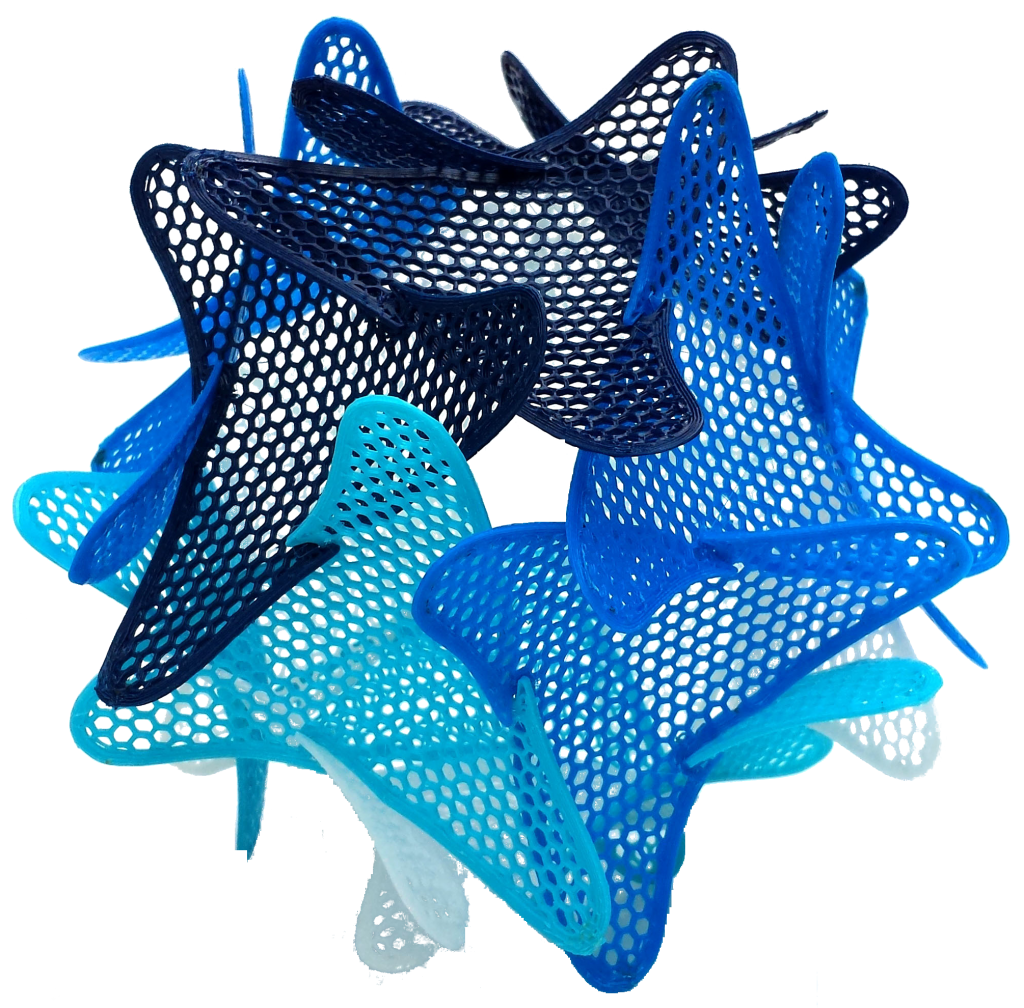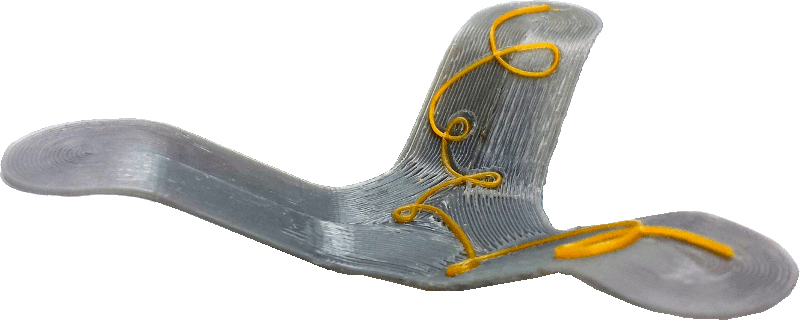 If you are used to using a 3D Printer such as a MakerBot, Cubify, Solidoodle, RepRap, Lulzbot, or any other FDM (fused deposition modeling) printer, you can probably relate to several issues.
If you are used to using a 3D Printer such as a MakerBot, Cubify, Solidoodle, RepRap, Lulzbot, or any other FDM (fused deposition modeling) printer, you can probably relate to several issues.
FDM printers traditionally print in layers. They print from the ground up, and only utilize their Z-axis (vertical axis) to move up a layer, once the current layer is finished printing. This has been the case ever since FDM printers have burst onto the 3D printing scene. No one has ever succeeded in utilizing these printers in a different way, using a totally different method, in order to increase the quality of output. That is until Topolabs came up with quite a brilliant idea.
Layering, or “stair stepping” is an issue in the vast majority of objects printed on FDM printers, such as the MakerBot Replicator, or the Cubify Cube. By layering, we are referring to the fact that you can see with the naked eye, each layer that is printed. This can make objects very unattractive, and “cheap” looking (see image below).
When we talk about FDM in manufacturing, people laugh, simply because the quality just isn’t good enough for final products.
However Topolabs, plans to vastly change the landscape of FDM printing. Not by building a new printer, or modifying the hardware. Instead they are developing software that tells the printer to print in a totally different and previously unthought of way.
As the company points out, the other current problems with FDM printers are as follow:
1) Inter-layer weakness: If you’ve ever printed parts that need to flex or be screwed together as part of a machine, or need to take high forces, you have probably experienced parts breaking between the layers.
2) Limited graphics on products.
3) All items above, plus the aesthetics, prevent FDM from being useful for production parts.
Topolabs’ software changes all this. Instead of printing using the typical planar paths and layers, whereas the printer prints one layer on a 2-dimensional surface, before moving up on the Z-axis to print the following layers, their software does something different. It looks to see if there is a fundamentally non-planar shape to the part and creates paths for the printer to follow that match the shape of the part better. This means that all three axes of the printer move at once to deposit the filament along a path in space.
Instead of having the layered “stair step” look, the topolabs software basically allows you to choose whatever kind of texture that you want, including subtle, graceful lines that flow along the surface of the part(s).
There are more benefits to printing using this method, according to topolabs, including:
1) Strength: The material fibers deposited by the FDM process can be aligned with the structure and/or stress directions of the part, even if the part is a curved surface.
2) Flexibility: Non-planar thin shell parts and also “open mesh” type parts resembling fabric can be created which have much greater flexibility than typical striated horizontal layer FDM. When the fibers follow the structure (like fabric) you can make thin structures that flex. This is true even when using structural plastics like ABS, PET, nylon and PLA. Thin, strong flexible structures can be made with Topolabs software that simply weren’t practical with flat slicing.
3) Aesthetics: Line art can be created on most surfaces.
4) Connecting planar layers: There are some parts where flat, horizontal layers are still convenient, but current parts often break between layers. Topolabs has developed a patent-pending “riveting” technique that creates “orthogonal rivets” or extruded elements that tie each layer to the adjacent layers. With this technique you can create strong, functional parts that withstand high forces without splitting between layers. This technique lets FDM parts – even thin shells – come much closer to injection-molded part strength.
We had the chance to conduct a brief interview with Topolabs co-founder James Page:
3DPrint.com – What was the reason that you set out to create this software?
James Page – I always felt that FDM was capable of so much more than the coarse prototype-y parts that my first Stratasys machine from 2005 could make. I grew up on a tree farm and saw the similarity between forming parts with FDM and growing wood. Trees employ many clever tricks to strengthen their wood fiber structures as they grow. I sensed that if we could employ biomimicry in FDM we could greatly expand the range of items you could make both in terms of strength and aesthetics. I believe that FDM can even be used as a volume manufacturing technique. It has fundamental parallels to sewing and fabric (both of which also start with material on a spool and create sophisticated structures for many types of applications).
3DPrint.com – How easy is it to use?
James Page – We want people to have a magic experience. Some of the most prominent inputs to your projects will be sketches and photos. You can start with part files from 3D file sharing sites or your own creations and use your sketches and photos to customize them. There will be easy templates to get people going fast. There will also be advanced tools available for those who want to push the envelope. Now that the algorithms and API are in place, we’re dialing in the GUI.
3DPrint.com – What is the pricing?
James Page – We’ll offer licenses for cloud-based tools. The cloud gives us great flexibility in how we do the licensing. We’re working on a fremium model so there will be some level of useful tools that folks can use without a subscription. We haven’t settled on subscription prices, but there will be powerful creative and manufacturing tool sets tailored to both the maker community and business.
3DPrint.com – Can this be used with any FDM printers on the market today?
James Page – Most desktop FDM systems are compatible including almost all that use G-code. We plan to support all systems that use open control languages including Makerbots up to Gen 4. We will provide sample output code of various flavors that people can try out if they have any questions about compatibility. Printer companies are approaching us and we’re working with them to enable great experiences for their customers. We’ll also provide future updates regarding compatibility with specific closed-system printers. I should note on the hardware side that some people may want to add a longer nozzle to their system for clearance. Luckily nozzles can be < $10 and they are easy to swap.
3DPrint.com – Are you looking for funding of any sorts?
James Page – We expect to complete an angel round in the near future. We are also planning a Kickstarter or other crowdfunding campaign with a fun twist in the near future.
3DPrint.com – Do you have patents on this new technology?
James Page – Yes. We have multiple patents pending. We are also strongly considering providing an open source API. We’d like to enable the community to build on these tools in directions no-one has thought of yet.
3DPrint.com – Why don’t you think anyone else has come up with this brilliant idea yet?
James Page – It’s a really great question. There are a lot of smart people out there and the truth is that I’m sure others have considered at least some part of the overall concept of 3d paths. S. Scott Crump mentions them in one of his early patents in 1989. I held off developing this seriously for a couple years because I assumed that someone else must have already perfected it somewhere. But in 2011 and 2012 I searched and didn’t find that anyone had pushed it to completion. I suspect what happened in the early days of FDM, was that it took a lot of work to refine and operationalize just the 2D layer process. By the time that happened, companies had started to calcify around the 2D slice schema. Stratasys and others built machines that had short, wide nozzles to optimize as far as possible the consistency of the 2D slice building process. That hard-coded the 2D way of working into their hardware, and then into the markets and the minds of people everywhere. The recent explosion of open source, low-cost hardware is serendipitously much more amenable to 3D paths. It’s also worth noting that there are a lot of subtleties to getting good quality. Moving in 3D was easy. Getting the details right was a lot harder.
3DPrint.com – How do you see this new method of 3D printing influencing us in ways we haven’t imagined before?
James Page – Using FDM for manufacturing is very controversial. Many don’t believe it is possible or makes sense. Those who don’t think 3D printing can be used for manufacturing are slowly dying off due to lack of imagination, but the mention of FDM and manufacturing in the same sentence still seems to get the skeptics worked up. I would again bring up the sewing machine analogy and point out how useful fabric and embroidery are. I think that with improved control, FDM can be extremely useful for making flexible, fabric-like structures. Right now we think about mass produced plastic parts as smooth, hard objects, and we think about fabric or leather as being good for flexible textured “fabricy” things and we think those are different categories. I think that our ideas about materials and categories will change as FDM bridges those two concepts. You’ll be able to have items made with areas flexible like fabric plus stiff, strong areas in the same part and you can have any texture you want because you don’t have to deal with the limitations of molding. FDM is also interesting because it is inherently low-cost and just needs a quality boost. This is in contrast to the other high quality / high cost techniques like SLS and DMLS where the battle has to be all about cost. We’re also excited about SLS, SLA and DMLS by the way. Stay tuned.
Jame Page, and Topolabs seem to have mastered the craft of printing 3D objects using an actual 3-dimensional print method. This is something that surprising hasn’t been brought to market yet by anyone else. If all goes as planned, this software should be made available sometime in the Summer of 2014. Could this incredible new method of 3D printing open the flood gates to the industry? If it is possible to make high quality printouts using cheap FDM printers, this could have a huge effect on manufacturing. Let us know what you think and ask James Page any questions you may have in the Topolabs thread on 3DPrintBoard.
Subscribe to Our Email Newsletter
Stay up-to-date on all the latest news from the 3D printing industry and receive information and offers from third party vendors.
You May Also Like
3D Printing Financials: Fathom Struggles in Financial Quicksand During Critical Transition
Facing a year of key transitions and financial pressures, Fathom (Nasdaq: FTHM) has filed its annual report for 2023 with the U.S. Securities and Exchange Commission (SEC). The document outlines...
Latest Earnings Overview for Australian 3D Printing Firms Titomic and AML3D
Australian 3D printing manufacturing firms Titomic (ASX: TTT) and AML3D (ASX: AL3) reported their financial results for the period from July to December 2023, marking the first half of their...
3D Printing Webinar and Event Roundup: April 7, 2024
Webinars and events in the 3D printing industry are picking back up this week! Sea-Air-Space is coming to Maryland, and SAE International is sponsoring a 3D Systems webinar about 3D...
3D Printing Financials: Unpacking Farsoon and BLT’s 2023 Performance
In the Chinese 3D printing industry, two companies, Farsoon (SHA: 688433) and Bright Laser Technologies, or BLT (SHA: 688333), have recently unveiled their full-year earnings for 2023. Farsoon reported increases...



































